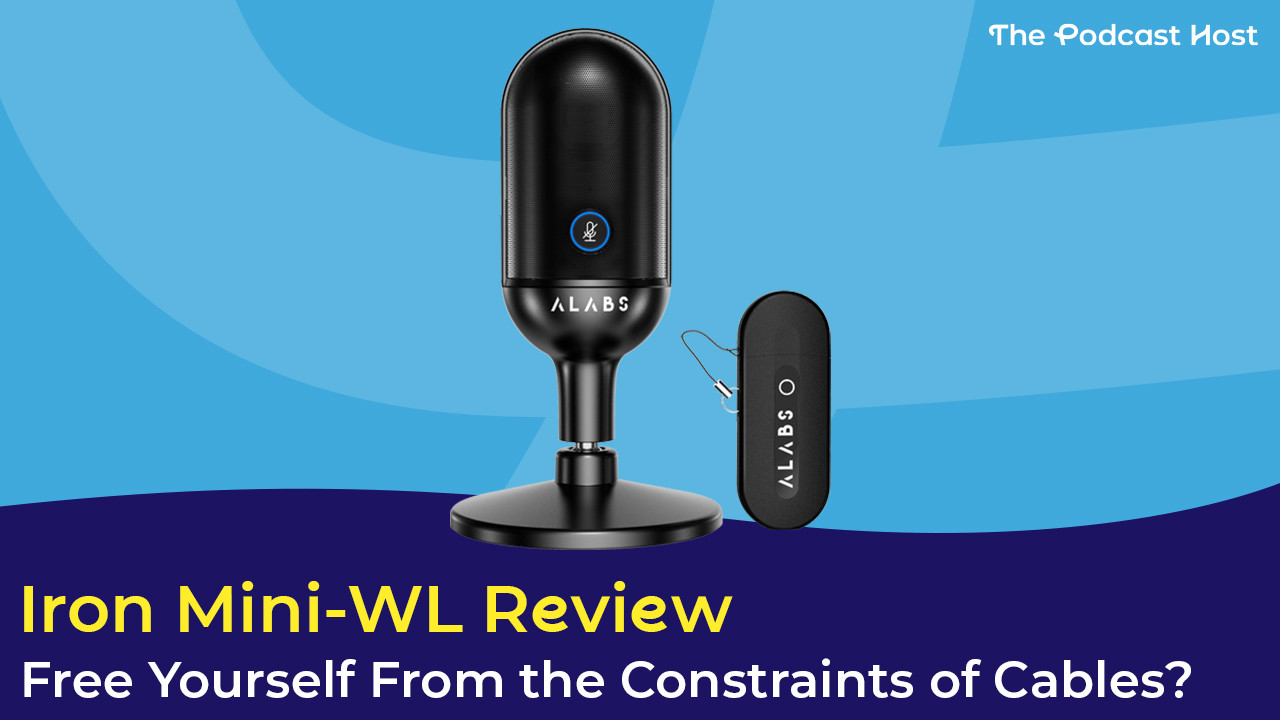Alabs Iron Mini-WL Review: Cable Free Desktop Recording

Wireless microphones are modern pieces of tech which make it easier than ever to start recording with little know-how of the recording process. With the ability to transmit sound wirelessly, they have become a favourite tool for podcasters and other content creators worldwide. Here at The Podcast Host, we have looked at a few wireless mics in previous reviews. Most of these have taken the shape of a lav-style mic that utilizes Bluetooth or a frequency that overlaps with internet wireless signals. On the other hand, the Iron Mini-WL is a desktop mic that utilizes UHF. If you’re wondering what that is and why it matters, you’ve landed on the right post.

In this Alabs Iron Mini-WL review, I’m going to:
- Test the overall recording quality
- Test the Signal Extraction Refinement claim
- Perform plosive tests
- And more!

Editor’s Note
The Alabs Iron Mini-WIL was provided for review purposes. Our Amazon link is an affiliate, so we may earn a small commission should you choose to buy through it.

What is the Iron Mini-WL?
“…the IRON MINI WL was designed specifically for recording vocals. 14mm acoustic diaphragm, cardioid directional pattern & sampling rate of 48kHz/24bit.”
Alabs
What Makes This Wireless Mic Unique?
This mic uses UHF (ultra-high frequency) for wireless transmission. In a nutshell, this means there is less chance of interference issues than wireless mics that use Bluetooth or the 2.4GHz that overlaps with internet wireless signals.
Why?
As the name suggests, it uses a higher frequency range to transmit signal compared to many devices consumers use on a daily basis. This means less chance of frequency overlap. The Iron Mini-WL microphone can connect to a computer or cellphone without downloading extra software or drivers. It is, indeed, plug-and-play while eliminating the need for an interface and cables.
The mic itself is simple. It has a mute button and a USB port for charging.

But how does it perform?
Initial Recording Test of the Iron Mini-WL
My initial recording came out at -31.28RMS or -29.8LUFS for recording levels – this is just barely at the cusp of “Okay”. I think the overall tone is that of a consumer-grade mic and not professional-grade. I also hear hiss at this lower recording level, which means it’ll only get louder when you boost your levels post-recording.
If you use this mic, you’ll want to use a software/app with input gain level controls within the software to help get healthier levels. If used for video conferencing, you can turn on auto-mic level for most platforms.
Plosive Test for the Iron Mini-WL
There were some popping plosives. This was expected as there was no built-in pop screen. However, the desktop stand can swivel. By slightly arcing the mic back, I alleviated the plosive issue at the recording stage. It’s also worth noting that the nut on the mic can be removed to place the mic on the stand or boom arm of your choice. This will help with finding your best mic placement, as well as adding in a pop filter.
Off-Axis Test for the Iron Mini-WL
As you can hear in the recording below, the tone changes noticeably with slight movements to the left and right. If you use this mic, it’s super important to stay centered to the diaphragm. I noticed, retrospectively, after reviewing my recordings, that if I hug the mic, the tone does improve, but then popping plosives become an issue.
Interference Findings
There weren’t any hum-based interference issues – even when using a cellphone as the recording device. There were a few clicks associated with fast in and out signal drops. However, this only occurred when I moved away from the recording device. The signal was stable once I stayed in one spot to conduct wireless “droppage” tests.

Signal Extraction Refinement Test for the Iron Mini-WL
Alabs claims that their Signal Extraction Refinement technology captures the “most charming” frequency range of your voice while suppressing noise. This sounds great on paper. But how does it perform in practice?
I recorded with a ceiling fan on to create some noise, and I didn’t notice much noise suppression, so if you use this mic, you’ll still want to be in a fairly quiet recording environment. As for the “charming frequency range of your voice” bit, this seems to work slightly better when you are fairly close to the mic.
It’ll be interesting to see how Alabs develops this concept further, but currently, it looks better on paper than practice when analyzing the results.
Who Would Benefit From the Iron Mini-WL
While I cannot recommend this mic for professional use, I can recommend it for:
- Online gaming
- Teleconference meetings
- Desktop mic for voice input commands
Conclusion
The MSRP looks like the Alabs Iron Mini-WL will be $69.99 if you want one with the stand, and $49.99 for just the mic. A few “cons” have been mentioned throughout this review, like the hiss and low recording levels without extra help. For this price range, the mic performs as expected. I’d like to add that just because the Iron Mini-WL isn’t quite up to snuff for professional work, it’s not a bad mic. It’s easy to use and set up. As far as wireless mics go, it performs well without any interference issues. This mic best serves a consumer environment, so it’s a decent, affordable option if you game online or want to sound good in your Zoom meetings at work.
Our Rating: 3.8/5
- Build Quality: 3.5/5
- Recording Quality: 3.0/5
- Ease of Use: 5/5
